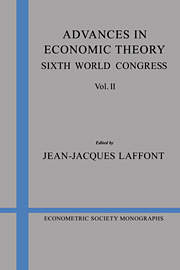Book contents
- Frontmatter
- Chapter 1 Behavior under risk: recent developments in theory and applications
- Chapter 2 Financial contracting theory
- Chapter 3 Collusion and the theory of organizations
- Chapter 4 The nature of incomplete security markets
- Chapter 5 Incomplete financial markets and indeterminacy of competitive equilibrium
- Chapter 6 Endogenous fluctuations
- Chapter 7 Equilibrium in competitive, infinite dimensional settings
- Chapter 8 Infinite-dimensional equilibrium theory: discussion of Jones
Chapter 1 - Behavior under risk: recent developments in theory and applications
Published online by Cambridge University Press: 05 January 2013
- Frontmatter
- Chapter 1 Behavior under risk: recent developments in theory and applications
- Chapter 2 Financial contracting theory
- Chapter 3 Collusion and the theory of organizations
- Chapter 4 The nature of incomplete security markets
- Chapter 5 Incomplete financial markets and indeterminacy of competitive equilibrium
- Chapter 6 Endogenous fluctuations
- Chapter 7 Equilibrium in competitive, infinite dimensional settings
- Chapter 8 Infinite-dimensional equilibrium theory: discussion of Jones
Summary
INTRODUCTION
In the last decade a number of new theories have been proposed to explain individual behavior under risk where, following Knight (1921), risk is defined as randomness with a known probability distribution. Some of these theories are formally atemporal and generalize the classical expected utility model of choice. Their development was inspired primarily by the growing body of laboratory evidence regarding static or one-shot choices, that has cast doubt upon the descriptive validity of the expected utility model. Other theories are explicitly intertemporal and generalize the time-additive expected utility model which is standard in capital theory. The noted laboratory evidence also provides some motivation for this work since it is clearly desirable that a theory of intertemporal utility, when restricted to static gambles, be consistent with the evidence.
The capacity to explain behavior in the laboratory is one criterion that might be applied to a theory of choice under risk. At least as important, however, is that the theory be useful as an engine of inquiry into standard market-based economic questions. The expected utility model has proven extremely successful in this respect. By application of now standard techniques, modelers have been able to derive a rich set of predictions in a variety of contexts. Moreover, a substantial body of non-experimental evidence has been shown to conform well to the expected utility hypothesis. The ultimate influence of the new theories on the profession at large will probably depend on whether they can match the elegance and power of expected utility as a tool of analysis and whether they can significantly improve the explanation of non-experimental evidence. In order to cast light upon these questions, I will survey some of the new theories of choice and their applications to a number of standard problems in macroeconomics, finance, and game theory.
- Type
- Chapter
- Information
- Advances in Economic TheorySixth World Congress, pp. 1 - 63Publisher: Cambridge University PressPrint publication year: 1993
- 13
- Cited by

